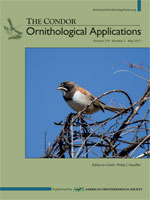Last winter I saw a Pink-footed Goose (Anser brachyrhynchus) at a small lake not far from my home. This is a species I have seen many times, including flocks of thousands annually during much of my childhood. And yet I went out of my way to see this one because it was a bird I had never seen in Connecticut, where I now live. I'm neither a big chaser of rare species nor a very serious lister, but—like many in the field—I was a birder before I became an ornithologist, and the allure of the vagrant is hard to shake. For those of us who live in North America, Howell, Lewington, and Russell have provided a wonderfully detailed compendium of information on those species that have traditionally been relegated to the final pages of a field guide. Readers of this book will learn that the first widely accepted Pink-footed Goose record comes from Newfoundland in 1990, but that they are now found annually in the Northeast. They will also learn about an early Delaware record, long considered an escapee (though perhaps not, given the recent pattern of sightings); that the North American increase parallels rapid growth of the population in Europe; and that other Eurasian geese are also becoming more common on the left side of the Atlantic.
The book is far more than a well-written compilation of rare records, however. Throughout, there is scholarly attention to detail, with careful definition of terms and exhaustive information about each species. In addition to summarizing the records, every species account includes a concise commentary that provides context for the observed pattern and informed speculation about the underlying causes. Identification is also covered, with a greater emphasis on how to distinguish each rarity from similar North American species than one would find in a typical field guide. Even family monographs tend to gloss over the finer points of identification when species are unlikely to co-occur, making this information invaluable for those looking to find their own rarities or to evaluate the identifications of others. And for those who do not make annual trips to spend migration in the remoter parts of the Bering Sea or dream about finding an elaenia in the backyard, the identification sections offer much to help sharpen one's birding skills.
In addition to the thorough species accounts that form the bulk of the book, the Introduction provides a comprehensive and clear discussion of vagrancy: how it is defined; the prevailing hypotheses for why it occurs; the limitations of available data; and insights into the types of new information that we need in order to better evaluate which hypotheses are best. Each explanation is nicely reviewed, with detailed examples, often involving specific birds that will be familiar to anyone who follows the North American birding scene. By highlighting these well-known records, the authors shed light on the general patterns they are describing, while also illustrating how we can learn from individual cases.
The text is further augmented by Lewington's magnificent paintings, each one capturing its subject to the core. Each species receives full treatment, with a range of poses and plumages, carefully chosen to show key identification features. Confusion species are often illustrated to allow easy comparison—for instance, Great Blue Heron (Ardea herodias), American Coot (Fulica americana), and Northern Harrier (Circus cyaneus) are each shown in matched poses to their Eurasian counterparts. The illustrations also build on an emergent theme of the book, which is that we need to record better information about vagrants if we are to better understand vagrancy. Identification to age, as well as species, repeatedly comes up as something that would help tease apart the alternative hypotheses—and as data that we often lack. With the emergence of inexpensive superzoom cameras on top of the seemingly continuous growth of high-caliber bird photography, vagrants are increasingly captured from every angle, making retrospective study easier. But there will always be cases where field observations are crucial, and the introductory material on molt and aging, combined with details in the species accounts, will help us accumulate the necessary knowledge that can be gathered only by a collective effort over many years.
Vagrants often are seen as biological curiosities, largely irrelevant to a species' ecology, and few scientists have taken a serious interest. But, as studies of Blackcaps (Sylvia atricapilla) in Europe and western hummingbirds in North America have demonstrated, we can sometimes learn a lot about migration and the factors that determine range limits when birds show up in unusual places. Moreover, as rates of global change accelerate—whether from habitat conversion, climate change, or less overt shifts such as the expansion of global shipping routes—we are seeing widespread changes in the temporal and spatial distributions of many species. The increasing reporting of northern Pacific seabirds in the Atlantic, both in northeastern North America and in western Europe—coincident with the rapid decline of Arctic sea ice—perhaps illustrates another reason that we should take these apparent oddballs, and what we can learn from them, more seriously. Rare Birds of North America provides a superb point from which to build on the few existing studies (e.g., by Dick Veit, Ian McLaren, and Alex Lees, among others) that have begun to make a systematic quantitative study of vagrancy patterns.
This book will be of great value, not only to those who like to chase rarities (all of whom should buy it immediately), but also to anyone with a serious interest in how and why vagrancy occurs, and its repercussions for our understanding of why birds show up where they do.






